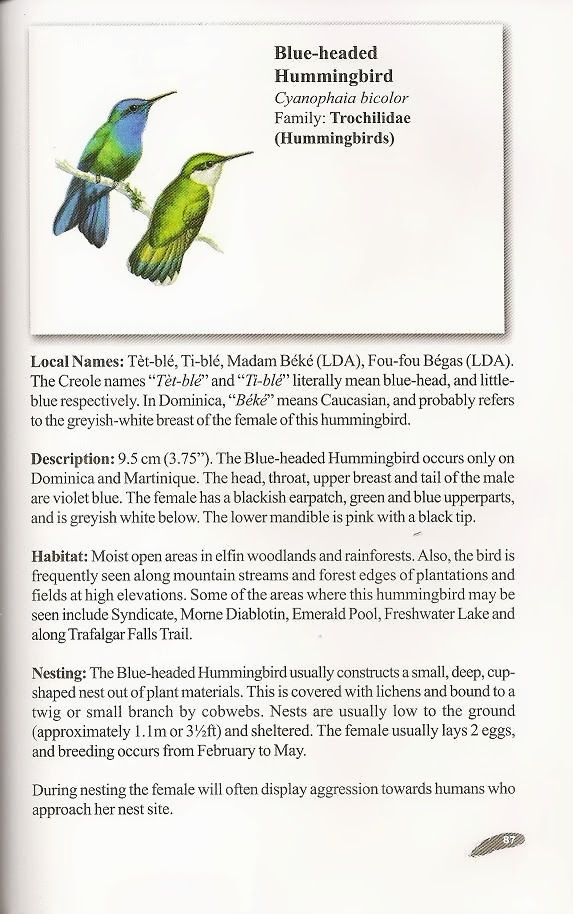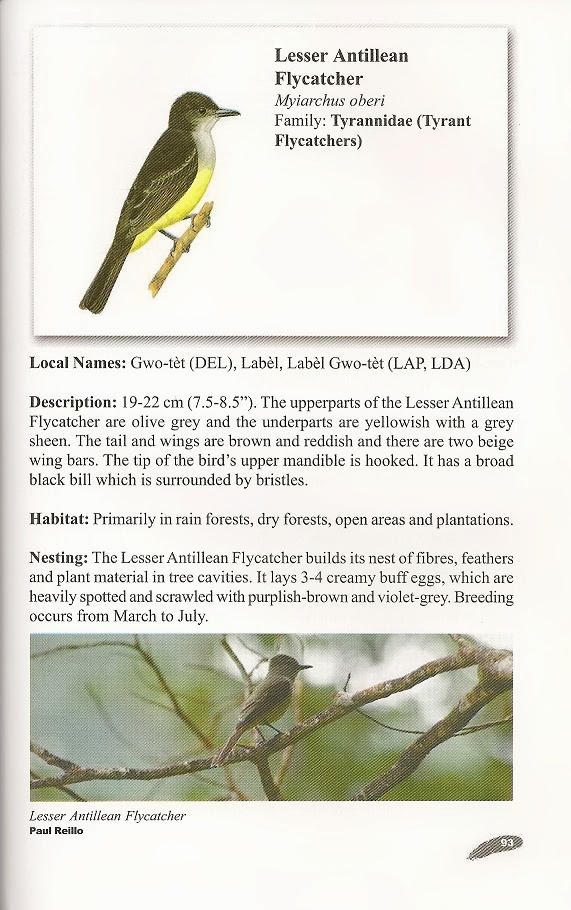Dominica's Birds
by Arlington, James, Stephen Durand and Bertrand Jno Baptiste
2005, 135pp, ISBN: Unknown
Basics: softcover; a general introduction of the island's birds provides a 1-page account plus a color illustration for each of 65 (40%) of the birds known from the island country; 10 color photos show 5 birds plus habitat, flowers, and a nest; text covers description, habitat, nesting, and folklore; 26 pages give an overview of the bird life, legislation and protections of the birds, and a nice cultural perspective that gives 37 different bird-related metaphors, proverbs, and expressions used by the local population
 This book introduces the reader to 65 of Dominica's primary birds, which accounts for about 40% of all the species that nest, visit, or migrate through the region. Each of the 65 species is reviewed with its own 1-2 page account and shown with a single nice color illustration. Some birds have two illustrations if there are notable differences in male/female or breeding/non-breeding plumages. Although these illustrations are not geared to show all details and variations of the many plumages possible, they are good enough to help the reader identify the birds shown in the book.
This book introduces the reader to 65 of Dominica's primary birds, which accounts for about 40% of all the species that nest, visit, or migrate through the region. Each of the 65 species is reviewed with its own 1-2 page account and shown with a single nice color illustration. Some birds have two illustrations if there are notable differences in male/female or breeding/non-breeding plumages. Although these illustrations are not geared to show all details and variations of the many plumages possible, they are good enough to help the reader identify the birds shown in the book.
Accompanying the illustrations are 10 color photographs. Five photos are of birds, 2 of habitat, 2 flowers, and 1 bird nest. It was good to see both of the endemic birds (Imperial Parrot and Red-necked Parrot) given the extra attention of a color photograph. The rarity and uniqueness of these birds make them deserving of being highlighted.
 The text for each bird consists of a paragraph on description with more material on habitat, nesting (if applicable), local names, and folklore. The description typically gives a general overview of the bird, pointing out the key color patterns or body parts of each bird. This material is not as detailed or thorough as the information found in other more complete field guides; but, accompanied with the illustration, it will certainly give the casual birder a nice image of the bird.
The text for each bird consists of a paragraph on description with more material on habitat, nesting (if applicable), local names, and folklore. The description typically gives a general overview of the bird, pointing out the key color patterns or body parts of each bird. This material is not as detailed or thorough as the information found in other more complete field guides; but, accompanied with the illustration, it will certainly give the casual birder a nice image of the bird.
It was nice to see an extended amount of information provided for the island's two endemic species. The information includes extra material on description, natural history, and the bird's special importance with the island. Perhaps as an oversight, no mention is made of the Imperial Parrot as being endemic! The only place in the book where this is notated is hidden in a single sentence in the introductory overview of the island on page 16. However, a note is made in the species account about the Red-necked Parrot being found on only Dominica along with comments on two near-endemic birds, Blue-headed Hummingbird and Plumbeous Warbler.
 It was the last section in the species accounts, folklore, that makes this book both unique and special. For many of the birds, the special relationship between the local populace and the birds is highlighted. This is done by pointing out special sayings and cultural beliefs. After reading the account for the Ringed Kingfisher or the Carib Grackle, you will discover when one of these birds calls over a residential area, one of the community's women is pregnant. Or, that it is time to leave the forest when the Forest Thrush sings what is translated as "It's six o'clock. Time to leave. Darkness."
It was the last section in the species accounts, folklore, that makes this book both unique and special. For many of the birds, the special relationship between the local populace and the birds is highlighted. This is done by pointing out special sayings and cultural beliefs. After reading the account for the Ringed Kingfisher or the Carib Grackle, you will discover when one of these birds calls over a residential area, one of the community's women is pregnant. Or, that it is time to leave the forest when the Forest Thrush sings what is translated as "It's six o'clock. Time to leave. Darkness." Adding to the cultural aspects of birds in Dominica, 15 pages are dedicated to share 37 metaphors, proverbs, and expressions that involve birds in many names of geographical points, businesses, plants, clubs, and sports teams. Examples translate into "your legs are thin like those of a sandpiper"; and, for someone with a large posterior may hear their figure being compared to that of a ground-dove.
Adding to the cultural aspects of birds in Dominica, 15 pages are dedicated to share 37 metaphors, proverbs, and expressions that involve birds in many names of geographical points, businesses, plants, clubs, and sports teams. Examples translate into "your legs are thin like those of a sandpiper"; and, for someone with a large posterior may hear their figure being compared to that of a ground-dove.
Several more pages focus on special legislation and on conservation of the island that is geared to protect its natural resources and birdlife.
The only small glitch I noticed in the book was the missing illustration of the Rufous-throated Solitaire on page 99. Apparently, a printing error caused only the text to be printed, with a large empty box showing where the bird would have been illustrated.
 If you are the type of naturalist who likes to learn more about a particular locality to be visited, you will appreciate this book. It offers unique bird-related material you simply won't find anywhere else. It will be a nice book to read as you watch the birds from the porch of your cabin as you relax on vacation. If you require more intense identification of all the birds you may see on the island, then you'll need to supplement your visit with one of the field guides by Raffaele or by Arlott. Those books illustrate all the species as well as many plumages. – (written by Jack, shown with sample pages at Avian Review, May 2011)
If you are the type of naturalist who likes to learn more about a particular locality to be visited, you will appreciate this book. It offers unique bird-related material you simply won't find anywhere else. It will be a nice book to read as you watch the birds from the porch of your cabin as you relax on vacation. If you require more intense identification of all the birds you may see on the island, then you'll need to supplement your visit with one of the field guides by Raffaele or by Arlott. Those books illustrate all the species as well as many plumages. – (written by Jack, shown with sample pages at Avian Review, May 2011)
Special Note: This book may be difficult to locate. With a lot of stubborness, obsession to collect bird books, and a little bit of luck, I was finally able to track down a copy. Fortunately, I can pass along contact information for you to purchase a copy of this book directly from the author, Arlington James, who is located in Dominica. He has granted me permission to post the following, which was current as of April 2011…
E-mail: forestry@cwdom.dm
Phone: 767-266-5852 (Dominica -- Forestry, Wildlife and Parks Division)

My wife and I spent a day on Dominica last December with Bertrand as our guide. Lovely place, I wish we had time to see more of it (along with that frustrating Imperial Parrot). I wanted to pick up this book while I was there, but Bertrand didn't have any on him and we didn't have time to go get any. I guess I'll have to email them, I'd love to have it as a souvenir.
ReplyDelete